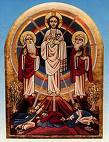Reflections on Mexico, Part II
I will save the largest issue of culture until last and focus this morning on Our Lady of Guadalupe.
I heard two stories about the image of Our Lady that I had not heard before. In the first, someone planted a bomb underneath it during the civil war. The bomb went off and destroyed all kinds of metal objects around the image and did not touch the image itself. In the second, the story goes, a German specialist was hired to do some cleaning of the image. As an avowed atheist however, he secretly conspired to ruin the image by applying acid to it. As he prepared to do this, Mary appeared to him in the image as a live person. Horrified, he dropped his weapons, at which point Our Lady smiled at him. He became a Catholic.
There are further the indisputable marvels of the image itself: the mystery of its production (who would have had the expertise to paint it?), its longevity (the fabric is made of vegetable matter and should have decayed by now), and the eyes (only recently, scientific analysis of the image revealed that in the pupils of the Virgin's eyes is the image of Bl. Juan Diego). Someone painting the image might have thought to depict her as half-European, half-American, but this is yet another amazing fact about the image. She is truly Queen of Peace.
Private revelations, according to official Church teaching, are not required belief for a Catholic, and so there is no particular danger in being a skeptic about these stories. Being at the basilica, hearing the stories and witnessing the faith of those devoted to O.L of Guadalupe, however, creates a rather weighty impression of veracity regarding the whole tradition. There is a plaque in a nearby church that reads, "God has not dealt thus with other nations [Ps. 147]." It is a striking confession for the nation that neighbors the 'almost chosen' land of liberty to the south. Mexico has been a land of tremendous suffering and we have not. I suppose many Americans harbor a secret sense of ourselves as greater for this. Are we ready to say with our Lord, "Blessed are the poor; blessed are they that mourn?" Surely this visit of Our Lady to Juan Diego is evidence of God's inscrutable choice at work.
These experiences in the end helped me clarify something about the relationship between America and Mexico. So often we hear about better cooperation between Catholics of the two countries, and almost inevitably this is couched in terms of higher standards of living for Mexico, refusal to exploit laborers there, and so on. Without question this is an important matter of justice, and one I've been aware of even before I was strongly practicing my faith. Do we hear often enough about the goods of the spiritual life to be gained by Americans from this proposed solidarity? How many Americans are really ready to hear that we might learn from Mexico? Out of those who would say they are, how many of those really want to learn and how many others want to exploit economic and cultural imbalances in the U.S. between hispanics and whites to promote personal agendas (I fear that this is a temptation in ministry: people who lack resources are easy prey for demagogues)?
Before we can answer these questions effectively, I would need to be more explicit about what is lacking in America versus Mexico. It is not, for example, that we don't use maracas at the liturgy. So in due time, I will make post #3 in which we look at the prerequisites for anything like an American Catholic culture, based on the examples I witnessed in Mexico.

1 comment:
A couple of years ago I was talking with a priest from Mexico, and he asked me why so many Mexicans go to the US. I replied, "Reconquista?" and he said, "Exactly!"
Don't know if he was pulling my leg, but it made perfect sense to me!
I'd be slow to assume who the exploiters are in this situation.
Post a Comment